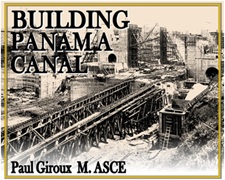
Building Panama Canal
Special Seminar
Thursday, September 26, 2013
5 - 6pm
131 DeBartolo
Raymond "Paul" Giroux, M.ASCE
District Quality Manager, Kiewit Corporation
In the late 19th century the great industrial powers of the world would seek to gain strategic control of the oceans. The only thing that stood in the way of dominating the Atlantic and Pacific Oceans was building a canal through a tiny fifty-mile stretch of land known as the Isthmus of Panama. The French completed the Suez Canal in 1869. Emboldened, the French would attempt to build at sea level a canal at Panama in 1870. Yet, Panama would conquer the French and they abandoned their effort in 1879. In 1904 President Teddy Roosevelt would commit the brains of American engineering and the brawn of America’s industrial machine to build a canal of unprecedented scope and challenge. Panama Canal’s successful construction was the result of the convergence of extraordinary men, machines, and methods. In the decades preceding Panama Canal’s construction, tremendous advancements were realized in every discipline of engineering. In the realm of heavy civil construction, these collective engineering advancements provided the construction technology that made Panama Canal possible. This presentation highlights how the right men, the right machines, and the right methods all came together in 1904 to build a project of unprecedented scope and challenges.

Paul Giroux received his BS in Construction Engineering from Iowa State University in 1979. For the past 33 years he has been with Kiewit Corporation, working on a wide variety of heavy civil engineering mega projects throughout the United States. Paul played a key role in notable projects such at the Fort McHenry Tunnel in Baltimore, several projects on the Big Dig in Boston -- including the new Zakim/Bunker Hill Bridge - and most recently, the new San Francisco Oakland Bay Bridge East Span. He is currently the District Quality Manager and Enterprise Resource Planning Deployment Manager for Northern California. Paul serves on the Iowa State University Civil Engineering Advisory Board, the Transportation Research Board, and is a corresponding member of the American Society of Civil Engineering (ASCE) History and Heritage Committee. Paul is the author of several bridge design and civil engineering history papers and is also an active public speaker. In addition to speaking at various industry meeting venues throughout the United States, Paul has presented over 180 lectures and seminars at nearly 40 engineering schools. Recently Paul was named as the recipient of the ASCE's prestigious Civil Engineering History and Heritage Award for 2013.